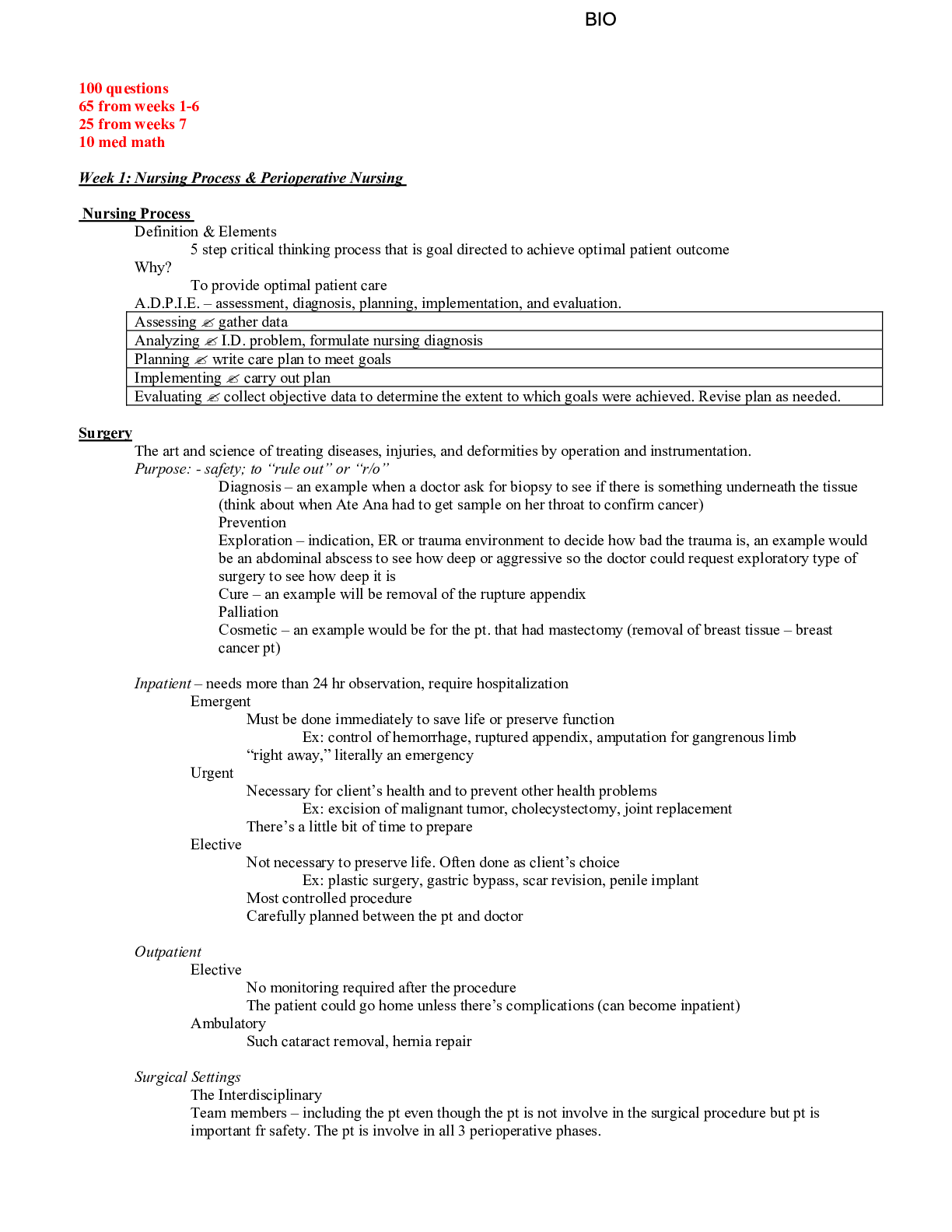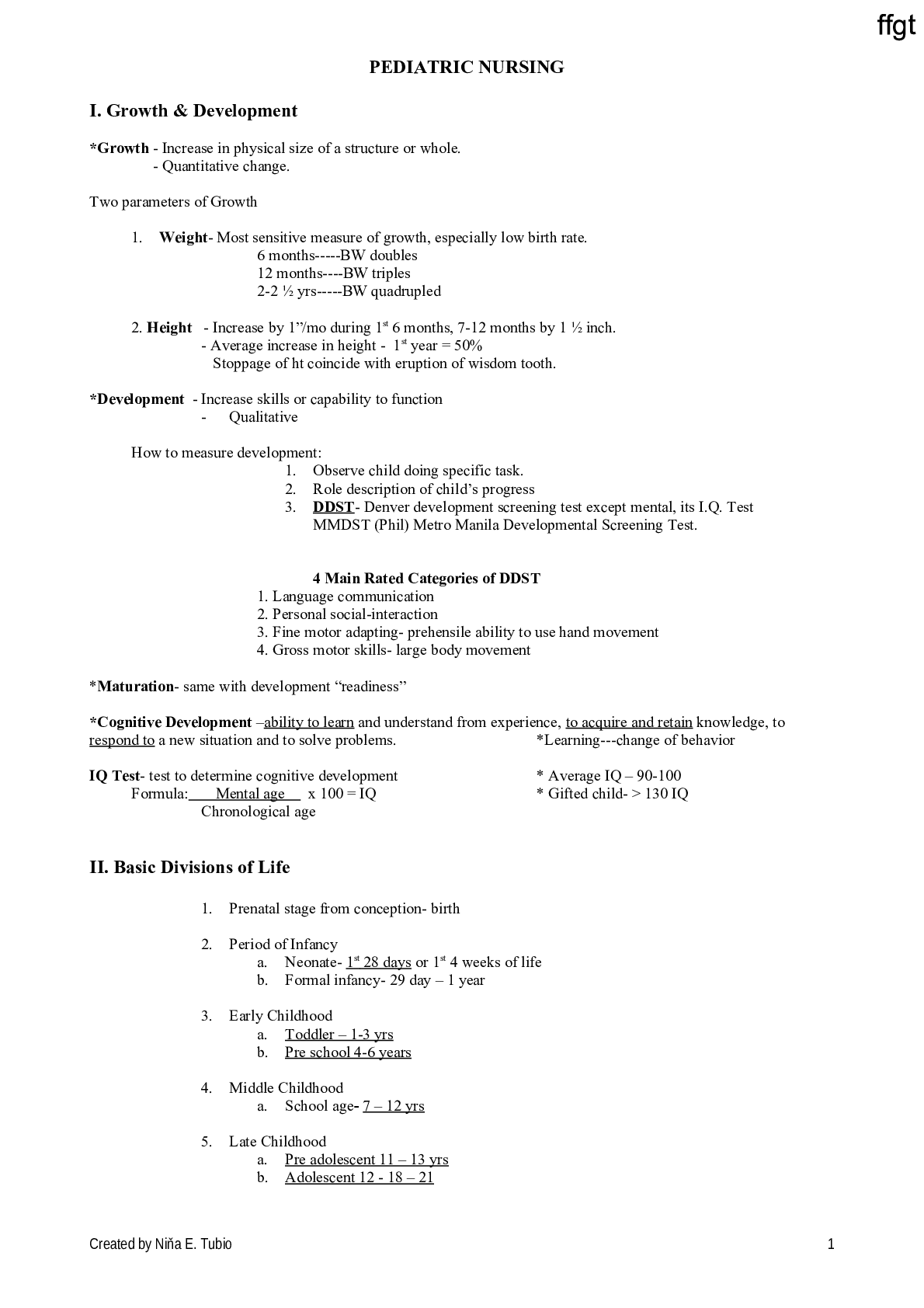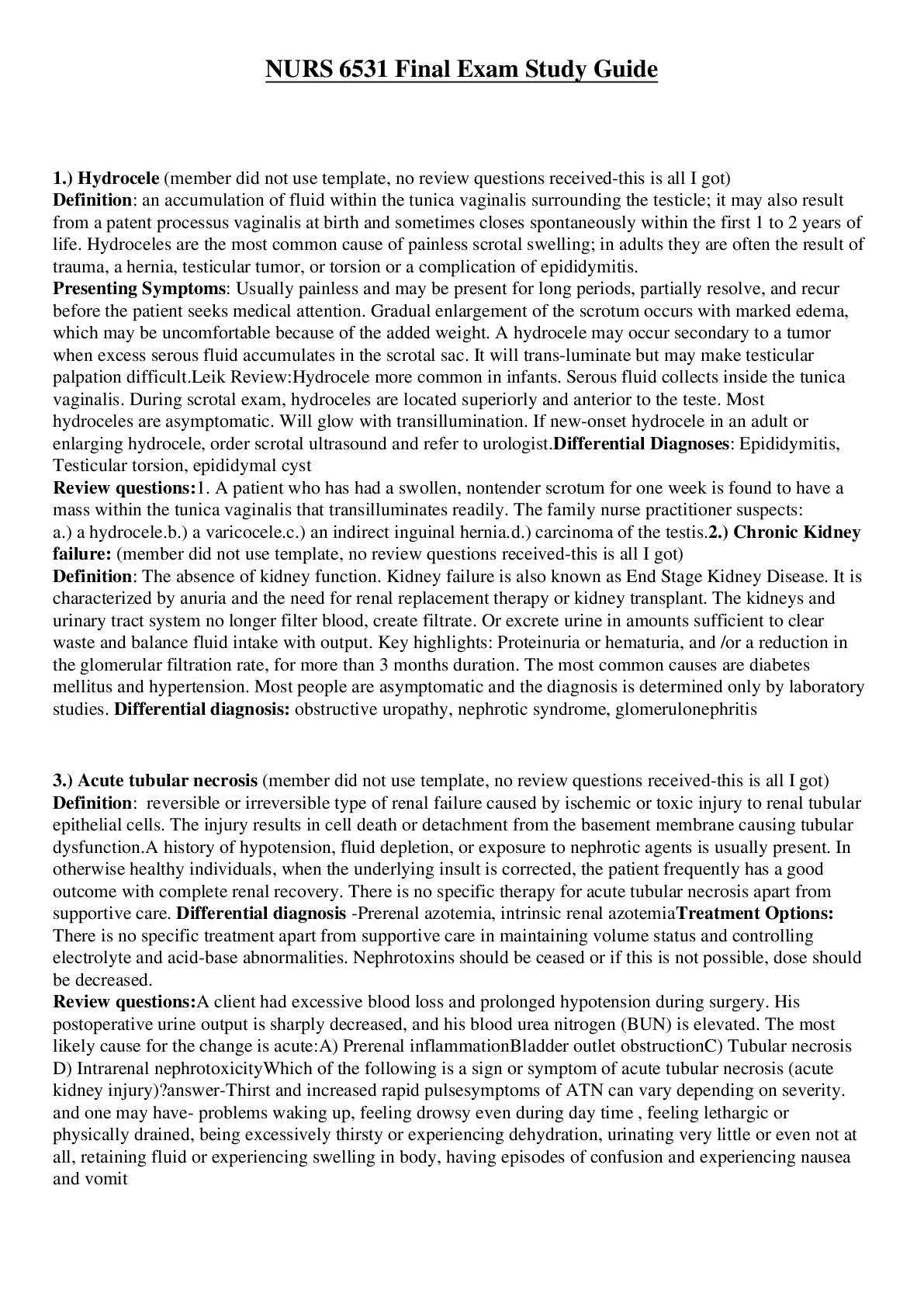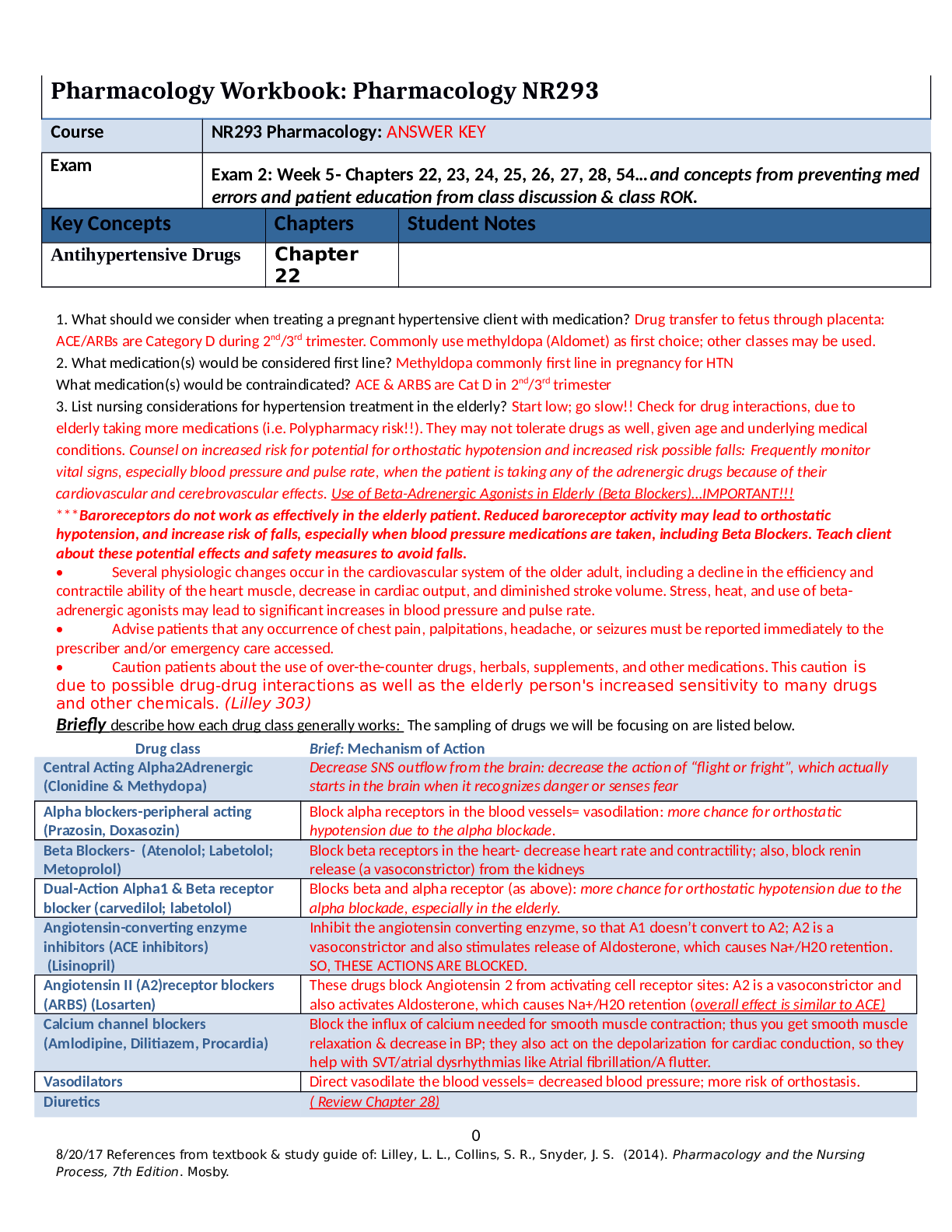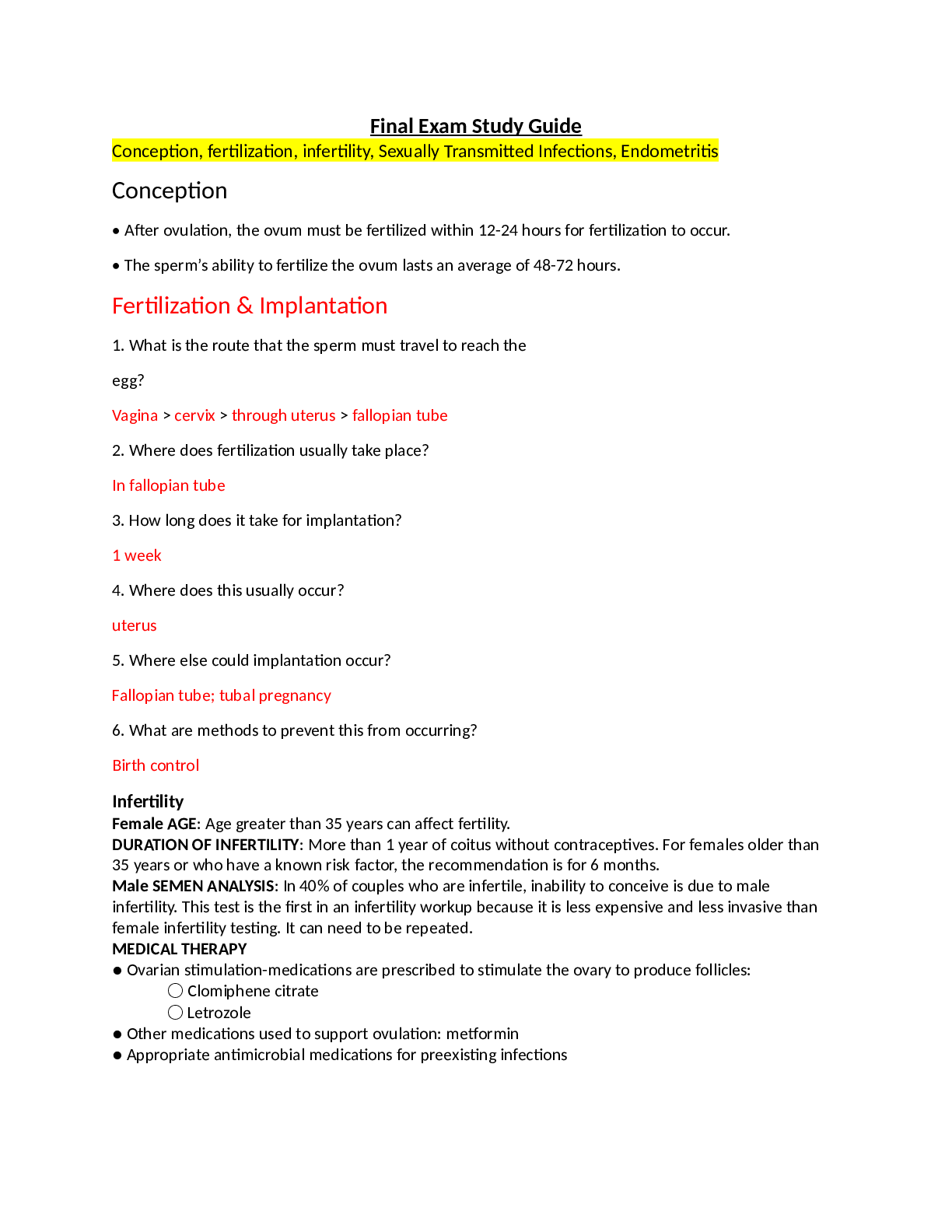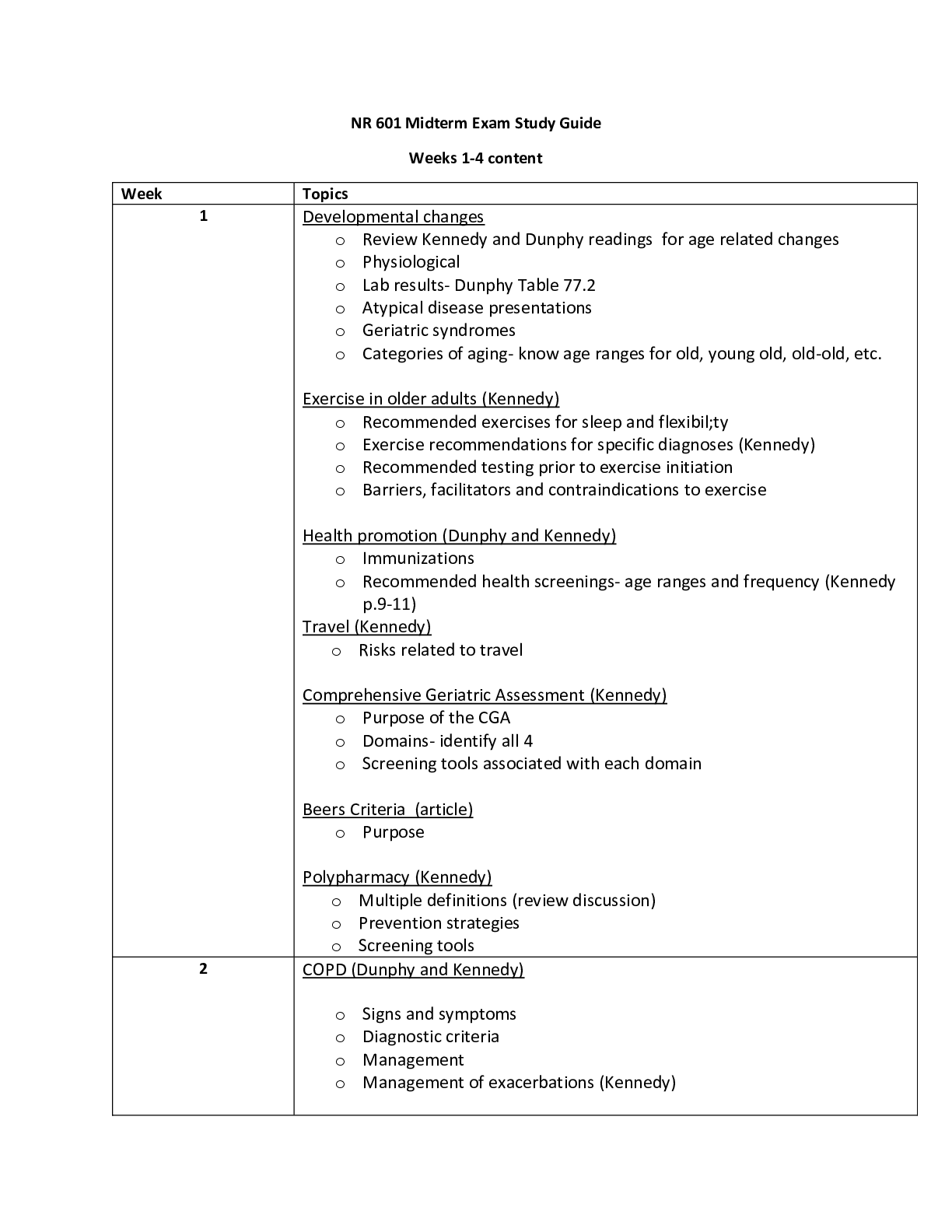*NURSING > STUDY GUIDE > NR 601 Midterm Exam Study Guide Weeks 1-4 content (All)
NR 601 Midterm Exam Study Guide Weeks 1-4 content
Document Content and Description Below
Week 1: Reading: Complete Dunphy, L.M., Winland-Brown, J. E., Porter, B.O. & Thomas, D.J. (2019). Primary Care-The art and science of Advanced Practice Nursing-An interprofessional approach. (5th ed... .) Philadelphia: F.A. Davis Company. Ch.77 Primary Care of Older Adults p. 1281-1292; (WO 1.1-1.3) Ch.77: Medications in the Elderly p.1292-1293; (WO 1.5) Kennedy-Malone, L., Plank, L. M., & Duffy, E. G. (2019). Advanced practice nursing in the care of older adults (2nd ed.). Philadelphia: F.A. Davis Company. Chapter 1: Changes with Aging (p.2-4); (WO 1.1-1.3) Chapter 2: Health Promotion (p.6-18); (WO 1.2) Chapter 3: Exercise in Older Adults (p.19-22); (WO 1.1-1.3) Chapter 4: Comprehensive Geriatric Assessment (p.26-33); (WO 1.4) Chapter 17: Polypharmacy (p.470-473); (WO2.3) Lessons: Complete Videos: Complete DE: Complete (if applicable) Week 2: Readings: Complete Dunphy, L.M., Winland-Brown, J. E., Porter, B.O. & Thomas, D.J. (2019). Primary Care-The art and science of Advanced Practice Nursing-An interprofessional approach. (5th ed.) Philadelphia: F.A. Davis Company. Chapter 28: Common Respiratory Complaints (p.357-361); (WO2.1-2.3) Chapter 29: Sleep apnea (p. 363-370); (WO2.4) Chapter 30: Pneumonia (p.375-384); (WO2.1) Chapter 31:(397-423); (WO 2.1-2.4) Kennedy-Malone, L., Plank, L. M., & Duffy, E. G. (2019). Advanced practice nursing in the care of older adults (2nd ed.). Philadelphia: F.A. Davis Company. Chapter 8: Chest Disorders; (WO2.1) Assessment of the respiratory system (p.154); (WO 2.1) Chronic obstructive pulmonary disease (p.164-170); (WO2.1-2.2) Pneumonia (p.191-196); (WO2.1-2.2) Lessons: Complete Videos: Complete DE: Complete (if applicable) 2 Week 3: Readings: Complete Dunphy, L.M., Winland-Brown, J. E., Porter, B.O. & Thomas, D.J. (2019). Primary Care-The art and science of Advanced Practice Nursing-An interprofessional approach. (5th ed.) Philadelphia: F.A. Davis Company. Chapter 70: Sleep Wake Disorders: Insomnia (p.1167-1173) (WO3.3) Chapter 64: Overview, Stress & Anxiety and Depressed Mood (p. 1055-1058) (WO3.1, 3.2) Chapter 67: Major Depressive disorder (p.1100-1110) (WO3.1, 3.2) Chapter 68: Generalized anxiety disorder (p. 1129-1135) (WO3.1-3.2) Kennedy-Malone, L., Plank, L. M., & Duffy, E. G. (2019). Advanced practice nursing in the care of older adults (2nd ed.). Philadelphia: F.A. Davis Company. Anxiety (p.434-436) (WO3.1-3.2) Bipolar disorder (p.436-438) (WO3.1-3.2) Depression (p.451-456) (WO3.1-3.2) Insomnia (p.461-462) (WO3.3) Grief and Bereavement (p.459-460) (WO3.5) Prescription drug misuse (p.436-465) (WO3.4) Lessons: Complete Videos: Complete Week 4: Readings: Complete DE: Complete (if applicable) Kennedy-Malone, L., Plank, L. M., & Duffy, E. G. (2019). Advanced practice nursing in the care of older adults (2nd ed.). Philadelphia: F.A. Davis Company. Osteoarthritis and Osteoporosis (p.851-870); (WO 4.1-4.3) Kennedy-Malone, L., Plank, L. M., & Duffy, E. G. (2019). Advanced practice nursing in the care of older adults (2nd ed.). Philadelphia: F.A. Davis Company. Osteoarthritis (p.315-319); (WO 4.1-4.2) Rheumatoid arthritis (p.322-325); (WO4.2) Lessons: Complete Videos: Complete DE: Complete (if applicable) Week Topics 1 Developmental changes 3 Review Kennedy and Dunphy readings for age related changes Replicative senescence is theory states that cells can replicate or divide a specific number of times. This ability tends to decrease with age. Oxidative damage is the cumulative result of the aerobic metabolism, which generates chemicals called free radicals. Free radicals may interact with other chemicals in the body and cause damage to cells. Telomere shortening is a theory that links aging to a reduction in cell division. Weakening of the immune response leaves older adults more vulnerable to infection and debilitating diseases. Physiological Age related Change Functional Change Implications Integumentary System Loss of dermal and epidermal thickness Loss of subcutaneous tissue and thin epidermis. Prone to skin breakdown and injury Decreased vascularity • Atrophy of sweat glands resulting in decreased sweat production • Decreased body odor • Decreased heat loss • Dryness • Alteration in thermoregulatory response • Fluid requirements may change seasonally • Loss of skin water • Increased risk of heat stroke Respiratory System Decreased lung tissue elasticity Decreased vital capacity Reduced overall efficiency of ventilatory exchange Cilia atrophy Change in mucociliary transport Increased susceptibility to infection Decreased respiratory muscle strength • Reduced ability to handle secretions and reduced effectiveness against noxious foreign particles • Partial inflation of lungs at rest Increased risk of atelectasis 4 Cardiovascular System Heart valves thicken and become fibrotic Reduced stroke volume, cardiac output; may be altered Decreased responsiveness to stress Fibroelastic thickening of the sinoatrial node; decreased number of pacemaker cells Slower heart rate Increased prevalence of arrhythmias Decreased baroreceptor sensitivity (stretch receptors) Decreased sensitivity to changes in blood pressure Prone to loss of balance, which increases the risk for falls GI Liver becomes smaller Decreased storage capacity Decreased muscle tone Altered motility Increases risk of constipation, functional bowel syndrome, esophageal spasm, diverticular disease Decreased basal metabolic rate (rate at which fuel is converted into energy) May need fewer calories [Show More]
Last updated: 2 years ago
Preview 1 out of 33 pages

Buy this document to get the full access instantly
Instant Download Access after purchase
Buy NowInstant download
We Accept:

Reviews( 0 )
$7.50
Can't find what you want? Try our AI powered Search
Document information
Connected school, study & course
About the document
Uploaded On
Apr 28, 2022
Number of pages
33
Written in
Additional information
This document has been written for:
Uploaded
Apr 28, 2022
Downloads
0
Views
59



